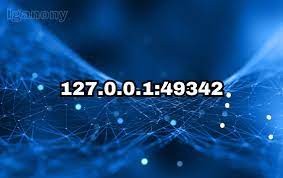The IP address associated with localhost is 127.0.0.1:49342 It is a standard address for testing and local development purposes. The port, 49342, is a specific entry point on the localhost for services. This article explains whatccccmeans, why it’s important, and how developers use it.
Understanding Localhost
Localhost is a term used in networking to refer to your own computer. The IP address 127.0.0.1 is reserved for localhost. Any communication sent to 127.0.0.1 is looped back to the same device. This process doesn’t involve external networks. It helps developers test their applications locally without needing a live network connection.
What is 127.0.0.1?
The IP address 127.0.0.1 is used to connect to the same machine. It is part of the IPv4 loopback addresses. This address allows devices to test applications and services internally. When you type 127.0.0.1 into a browser, the browser will connect to the web server on your own computer.
What is a Port?
A port is a communication endpoint for networking. Ports allow multiple applications to use the same IP address simultaneously. Think of a port like a door. It is the entry point for specific applications or services. Common examples include port 80 for HTTP and 443 for HTTPS.
What Does 127.0.0.1:49342 Mean?
When you see 127.0.0.1:49342, you are looking at a combination of an IP address and a port number. The IP address 127.0.0.1 refers to the local machine, while the port number 49342 specifies a particular service or application running on that machine. Ports range from 0 to 65535, and 49342 is one of the higher-numbered, often random ports used by web servers or other services.
Why Use 127.0.0.1:49342?
Using 127.0.0.1:49342 helps developers run and test applications locally. For example, a web server running on your machine may use 127.0.0.1:49342 to deliver content to your browser. This combination of IP address and port allows developers to ensure that their software works properly without involving an external network. It’s an essential tool for local testing.
How to Access 127.0.0.1:49342
Accessing 127.0.0.1:49342 is simple. Open your web browser and type the URL http://127.0.0.1:49342. If a local server is running on that port, the server’s content will load. If no server is running, you will likely see an error message, such as “Connection refused”.
Port Numbers: Dynamic vs. Static
Ports can either be dynamic or static. Static ports, like 80 or 443, are reserved for specific services. Dynamic ports, like 49342, are chosen randomly from a range of available ports. When you run a local service, it often uses a random dynamic port for communication. This helps avoid conflicts with other services.
Common Uses for 127.0.0.1:49342
There are several scenarios where 127.0.0.1:49342 might be used. One common example is during web development. If you’re developing a website using a local web server like Apache, Node.js, or Flask, it might run on 127.0.0.1:49342. Similarly, local database systems like MySQL or PostgreSQL might listen on such dynamic ports.
How to Check Which Port a Service Uses
To find out which port a service is using, open a terminal or command prompt. On Windows, use
netstat. Type:
netstat -a -n -o
On macOS or Linux, use:
ls of -i -P -n
These commands list all active connections and their ports. Look for the service or application to find the port number. If you’re running a web server, it should be similar.
Troubleshooting Issues with 127.0.0.1:49342
Sometimes, accessing Ip might not work. There are several reasons for this, and troubleshooting can help identify the issue.

1. The Service Isn’t Running
Ensure that the service you’re trying to access is running. If not, start the service and try again.
2. Port Conflict
If another application is using port 49342, there may be a conflict. Check your port usage and consider using a different port.
3. Firewall Blocking the Port
Your firewall settings might block the port. Ensure that the port 49342 is open in your firewall configuration.
4. Incorrect URL or Typo
Double-check the URL. Ensure you typed http://127.0.0.1:49342 correctly without missing any characters.
Changing the Port Number
You might need to change the port number if 49342 is in use or blocked. Most applications allow you to configure the port manually. For example, if you’re running a Node.js server, you can specify the port like this:
javascript
const port = 3000;
app.listen(port, () => {
console.log(`Server running on http://127.0.0.1:${port}`);
});
Change 3000 to any port you prefer. Restart your service after making changes.
Security Concerns with Localhost Ports
Though localhost ports like 127.0.0.1:49342 are used for local testing, they can still present security risks if not handled properly. Even though the connection is local, a misconfiguration might expose the port to external networks. Always ensure that your firewall settings are correct. Avoid using privileged ports or well-known ports without securing them.
Final Thoughts
127.0.0.1:49342 is a key tool for developers. It allows them to test applications locally, ensuring that everything works before going live. The combination of localhost and a random port provides flexibility and isolation from external networks. By understanding how 127.0.0.1:49342 works, you can make local development smoother and troubleshoot potential issues with ease.
Make sure to keep your ports secure and always check for conflicts before running local services. This will help ensure your localhost setup remains functional and safe. Happy coding!


